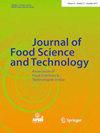Thiol-Cyclodextrin: A New Agent For Controlling The Catalytic Activity Of Polyphenol Oxidase From Red Delicious Apple
IF 3.3
3区 农林科学
Q2 FOOD SCIENCE & TECHNOLOGY
引用次数: 1
Abstract
Polyphenol oxidase (PPO, EC 1.14.18.1) is the main enzyme responsible for enzymatic browning, a natural process which produces deterioration of fruits and vegetables. One alternative to prevent this undesirable process is to inhibit the catalytic activity of PPO by encapsulating enzyme’s substrates in cyclodextrins (CD). In this article the effect of a Thiol-CD on PPO from Red Delicious apple was studied, demonstrating that this compound is a powerful tool for controlling oxidative processes in food. Thiol-CD could encapsulate the polyphenols, natural substrates of the enzyme, by means of the cyclodextrin hydrophobic internal cavity. Simultaneously, through the thiol group, it could inactivate the PPO by reducing the copper ions from the active site of the enzyme. Moreover, thiol moieties could decrease the browning by reducing the quinones generated by oxidative processes. The isolation and purification of PPO from apple was performed in order to study those effects, different polyphenols, chlorogenic acid (CA) and 4-methylcatechol (4-MC), were assayed as enzymatic substrates. Both β -CD and Thiol-CD exhibited better enzyme inhibition value for CA than for 4-MC. Moreover, Thiol-CD showed an extraordinary performance compared with β-CD. When CA 10 mM was used, 5 mM β-CD gave 11 % PPO inhibition, meanwhile nearly 100 times less concentration of Thiol-CD (45 μM) gave 100 % of enzyme inhibition.巯基环糊精:控制红鲜苹果多酚氧化酶催化活性的新药剂
多酚氧化酶(PPO, EC 1.14.18.1)是导致酶促褐变的主要酶,这是一种导致水果和蔬菜变质的自然过程。防止这种不良过程的一种替代方法是通过将酶的底物包封在环糊精(CD)中来抑制PPO的催化活性。本文研究了巯基cd对红美味苹果中PPO的影响,证明该化合物是控制食品氧化过程的有力工具。巯基cd可以通过环糊精疏水内腔包封酶的天然底物多酚。同时,通过巯基,它可以减少酶活性部位的铜离子,使PPO失活。此外,巯基可以通过减少氧化过程中产生的醌来减少褐变。为了研究苹果中PPO的分离纯化作用,以绿原酸(CA)和4-甲基儿茶酚(4-MC)为酶促底物进行了酶促活性测定。β -CD和Thiol-CD对CA的抑制作用均优于4-MC。此外,与β-CD相比,Thiol-CD表现出非凡的性能。当CA浓度为10 mM时,5 mM β-CD对PPO的抑制作用为11%,而低浓度的Thiol-CD (45 μM)对酶的抑制作用为100%。
本文章由计算机程序翻译,如有差异,请以英文原文为准。
求助全文
约1分钟内获得全文
求助全文
来源期刊
CiteScore
7.70
自引率
0.00%
发文量
274
审稿时长
11 months
期刊介绍:
The Journal of Food Science and Technology (JFST) is the official publication of the Association of Food Scientists and Technologists of India (AFSTI). This monthly publishes peer-reviewed research papers and reviews in all branches of science, technology, packaging and engineering of foods and food products. Special emphasis is given to fundamental and applied research findings that have potential for enhancing product quality, extend shelf life of fresh and processed food products and improve process efficiency. Critical reviews on new perspectives in food handling and processing, innovative and emerging technologies and trends and future research in food products and food industry byproducts are also welcome. The journal also publishes book reviews relevant to all aspects of food science, technology and engineering.

 求助内容:
求助内容: 应助结果提醒方式:
应助结果提醒方式:


